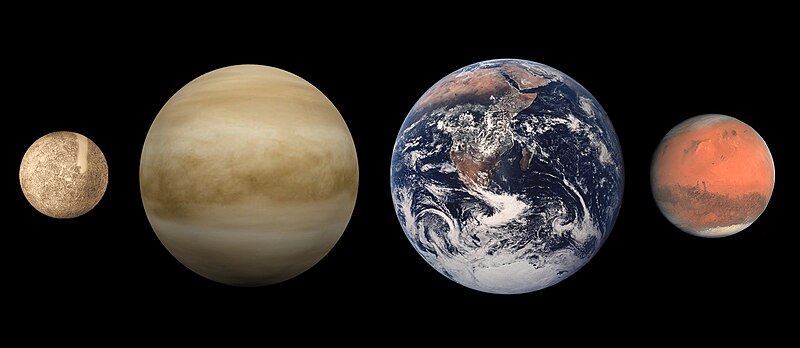फाइल:Terrestrial planet size comparisons.jpg

ऐ पूर्वदृश्यक आकार: ८०० × ३४८ चित्राणु. दोसर resolutions: ३२० × १३९ चित्राणु | ६४० × २७९ चित्राणु | १,५०० × ६५३ चित्राणु।
पूर्ण आनन्तर्य (१,५०० × ६५३ चित्राणु, फाइल आकार: ३१४ KB, माइम प्रकार: image/jpeg)
फाइल इतिहास
तखनका तिथि/ समए पर क्लिक करी जखनका फाइल देखबाक अछि
| तिथि/ समए | लघुचित्र | बीमसभ | प्रयोक्ता | समीक्षा | |
|---|---|---|---|---|---|
| अखनका | ०२:२४, ५ दिसम्बर २०१८ |  | १,५०० × ६५३ (३१४ KB) | Allice Hunter | Correcting Mars |
| २३:०६, ३ दिसम्बर २०१८ |  | १,५०० × ६५३ (३१५ KB) | Allice Hunter | updated: correcting the color of Mars. Based on image of Mars >> File:OSIRIS Mars true color.jpg. There was no distortion in size | |
| ०४:२२, १६ जुलाई २०१२ |  | १,५०० × ६५३ (२७६ KB) | Ubiquinoid | updated: correcting for apparent undersizing of Venus (from 90 to 95% (true) of Earth's diameter) - based on image of Venus w/NASA cloup map (resized) at http://cronodon.com/PlanetTech/Venus.html; centred | |
| २०:३७, १५ जुलाई २०१२ |  | १,५०० × ६५३ (७९ KB) | Ubiquinoid | updated: correcting for apparent undersizing of Venus (95% of Earth's diameter) - based on image of Venus w/cloup map (resized) at http://cronodon.com/PlanetTech/Venus.html | |
| ०५:३५, २८ दिसम्बर २००७ |  | १,५०० × ६५३ (४५६ KB) | Crotalus horridus~commonswiki | Created identical and more compact version using the "Huffman optimized" feature of jpegcrop. Nothing else has been changed. | |
| ०५:१२, १५ जुन २००६ |  | १,५०० × ६५३ (४८८ KB) | Nicke L | {{Information| |Description= The inner planets, from left to right: en:Mercury, en:Venus, en:Earth, and en:Mars Source: http://solarsystem.nasa.gov/multimedia/gallery/terr_sizes.jpg |Source= |Date= |Author=User [[:en:User:Brian0918|Br |
फाइलक उपयोग
एकोटा पन्ना नै अछि जे ई सञ्चिका सँ जुड़ल होए।
विश्वव्यापी फाइल उपयोग
ई फाइल कऽ उपयोग निम्न दोसर विकिसभमे अछि:
- af.wikipedia.org कऽ उपयोग पर
- arz.wikipedia.org कऽ उपयोग पर
- az.wikipedia.org कऽ उपयोग पर
- bat-smg.wikipedia.org कऽ उपयोग पर
- ba.wikipedia.org कऽ उपयोग पर
- be-tarask.wikipedia.org कऽ उपयोग पर
- beta.wikiversity.org कऽ उपयोग पर
- be.wikipedia.org कऽ उपयोग पर
- bxr.wikipedia.org कऽ उपयोग पर
- ca.wikipedia.org कऽ उपयोग पर
- cv.wikipedia.org कऽ उपयोग पर
- da.wikipedia.org कऽ उपयोग पर
- da.wikisource.org कऽ उपयोग पर
- de.wikipedia.org कऽ उपयोग पर
- de.wikisource.org कऽ उपयोग पर
- de.wikiversity.org कऽ उपयोग पर
- en.wikipedia.org कऽ उपयोग पर
- User:Can't sleep, clown will eat me
- User:Newone
- Wikipedia:Featured picture candidates/Terrestrial planet size comparisons
- Wikipedia:Featured picture candidates/May-2006
- Talk:Dwarf planet/Archive 1
- Wikipedia:Featured picture candidates/February-2007
- Wikipedia:Featured picture candidates/Terrestrial planets
- User:Can't sleep, clown will eat me/User/appetizers
- Wikipedia:Featured picture candidates/August-2007
- Wikipedia:Featured picture candidates/Terrestrial planet size comparisons.jpg
- User:Mitternacht90/EarthandSpace
- User:HarryAlffa/Solar System synopsis
- Talk:Solar System/Archive 5
- User:Physchim62/Planetmass
ई फाइलक विश्वव्यापी उपयोगक अधिक जानकारी देखी।

